Widely considered the most romantic (if most expensive) day of the year, Valentine’s day often brings with it pressure to spend more to prove one’s admiration. To help you avoid compromise on your Valentine’s day drinking, Wine Lister has put together a list of red Value pick MUST BUYs with WL scores above 95.
Click here to view all red Value pick MUST BUYs, or read more below.
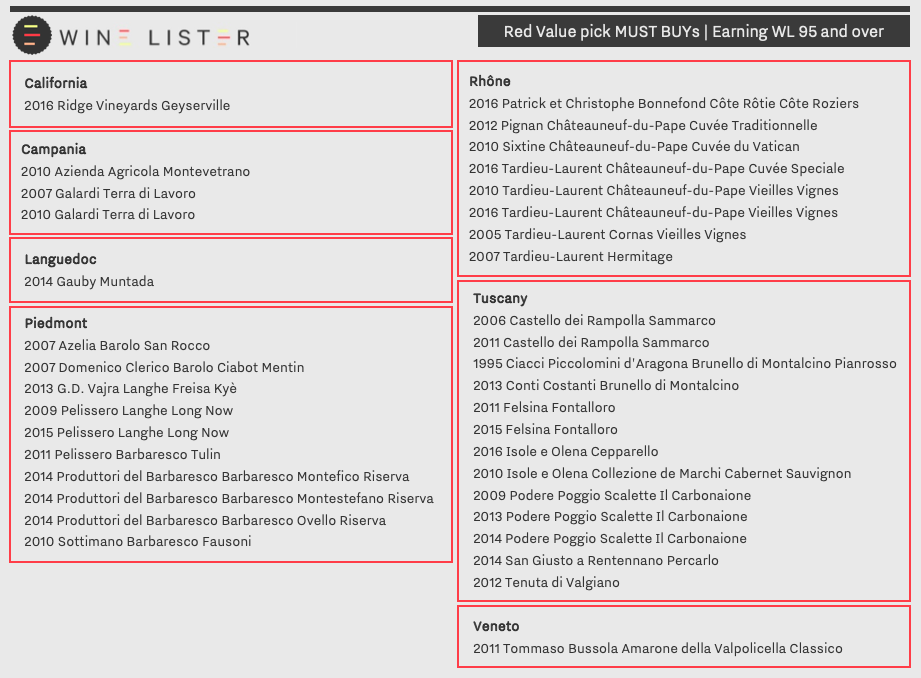
Of the 37 red Value Pick MUST BUYs earning WL 95 and over, a substantial 27 wines hail from Italy, suggesting the impressive quality-to-price ratios offered by many of the country’s producers.
A passion for Piedmont
Famed Piedmont cooperative, Produttori del Barbaresco appears three times on the list, with the 2014 vintages of its Montefico Riserva, Montestafano Riserva, and Ovello Riserva. Despite hailstorms damaging several Barbaresco vineyards in 2014, Produttori’s premium sites are subject to rigorous grape selection, meaning its single-vineyard wines retained quality in the vintage. Achieving the highest score of the three labels from Wine Lister partner critic, Antonio Galloni (96) who calls it a “potent, structured Barbaresco”, the Montefico Riserva can be purchased from Hatton & Edwards for £42 per bottle (in-bond).
Tenderness for Tuscany
Moving further south, Podere Poggio Scalette’s Il Carbonaione is represented by its 2009, 2013, and 2014 vintages, which all achieve WL scores of 95. With over 10 years of age, the 2009 is described by Wine Lister partner critic, Jancis Robinson, as offering a “very voluptuous, exotic nose”, with notes of “both herbs and spices – and some meatiness […] very exciting and bursting with health”. It can be bought from Atlas Fine Wines for £33 per bottle (in-bond).
A romance with the Rhône
Family-owned, micro-négociant, Tardieu-Laurent represents five of the eight Rhône Value picks, with its 2016 Châteauneuf-du-Pape Cuvée Speciale, 2010 Châteauneuf-du-Pape Vieilles Vignes, 2016 Châteauneuf-du-Pape Vieilles Vignes, 2005 Cornas Vieilles Vignes, and 2007 Hermitage. Despite its small-scale production (a consequence of its meticulous selection process), Tardieu-Laurent offers excellent value across its labels. Jancis Robinson awards 18 points to the 2016 Châteauneuf-du-Pape Vieilles Vignes, noting it is “very aromatic and then so sweet and round on the palate! You want to gobble it up immediately”. It can be purchased by the case of 12 from Tardieu-Laurent’s exclusive UK agent, Corney & Barrow for £390 (in-bond).
Caring for California
Representing the New World, Ridge Vineyards’ Geyserville appears in the line-up with its 2016 vintage. A single-site blend of 73% Zinfandel, 17% Carignan, 7% Petite Syrah, and 3% Alicante Bouschet, it achieves a WL score of 95, and is described by Antonio Galloni as offering “black cherry, graphite, lavender, and spice”, with “a purity […] that is absolutely striking”. Also noted by Jancis Robinson as having “snug, focused aromatics with hints of floral lift” and “a palate bursting with flavour”, the 2016 Geyserville can be acquired by the bottle from Lay & Wheeler for £33 (in-bond).
It is the ultimate question for Burgundy fans seeking wines for drinking – with prices of the region’s best having risen so high, where can one find value?
Wine Lister’s second Burgundy study published in collaboration with regional specialist, Jasper Morris, notes the proliferation of good value wines hailing from some of the lesser-known appellations, and even outside of the Côte d’Or (Saint-Aubin, Marsannay, Mercurey, and Pouilly-Fuissé were among those mentioned).
Below Wine Lister explores some of the wines worth snapping up from the 2019 campaign*, based on their relative value when compared with other wines in their sought-after appellations. 37 out of the 58 wines listed in charts below are white.

Chablis – a permanent alternative source for Burgundy drinking white outside of the Côte de Beaune – features heavily. Buzz brands William Fèvre and Billaud-Simon achieve multiple entries, as does the Chablis estate of Maison Albert Bichot – Long-Depaquit, and relative newcomer to the cream of the crop, Jean-Paul et Benoît Droin. This group of top Chablis achieves an average price of £52 in bond per bottle, while their Côte de Beaune counterparts cost more than 30% more for the same quality (since both groups achieve an average WL score of 93).
Among the Côte de Beaune whites, Alain Chavy’s Puligny-Montrachet Folatières, and Fontainte-Gagnard’s Chassagne-Montrachet Caillerets provide the best quality-to-price ratios, both achieving WL scores of 94, for £48 and £53 per bottle in-bond respectively. Domaine Rapet’s Corton-Charlemagne provides excellent value for Grand Cru white (considering that the appellation’s reference – Jean-François Coche-Dury – typically costs over £3,000 per bottle).

Only one Grand Cru red makes the cut in top-scorers under £100 per bottle – Georges Lignier’s Clos Saint-Denis.
In the rest of the Côte de Nuits, strong value propositions hail from Taupenot-Merme throughout, particularly its Morey-Saint-Denis La Riotte. Maison Louis Jadot and Heresztyn-Mazzini achieve multiple entries in Gevrey, and the Nuits-Saint-Georges appellation makes an appearance across three producers – Grivot, Faiveley, and Henri Gouges.
The average price difference between the reds of both Côtes is not so dramatic as for Chablis and its Beaune counterparts. Côte de Beaune reds as shown the image above reach an average price of £72, just 10% lower than the Côte de Nuits group (for the same average WL score of 92). Domaine de Montille takes three of the eight places for its Corton Clos du Roi, Volnay Taillepieds, and Pommard Pézerolles.
*N.B. prices are based on those aggregated through Wine Lister’s pricing partner, Wine Owners. Not all Burgundy 2019s have recorded prices as yet, so the above lists may well evolve over the coming weeks and months.
The last lot of Burgundy 2019 scores are in, from Wine Lister’s regional specialist critic, Jasper Morris (Inside Burgundy).
Below we explore Jasper’s top scores by Burgundy “subset”, as defined in Wine Lister’s recent study on the region (recap its key findings here).
While no wines earned perfect scores this year, Jasper’s highest score was in fact awarded to a Premier Cru performing beyond its classification – Arnoux-Lachaux’s Vosne-Romanée Aux Reignots. He notes that the wine is “completely heartbreakingly suave and sensational”, offering “crisply ripe cherries, alpine strawberry, the lightest raspberry touch, then a generous pure clear long finish”.
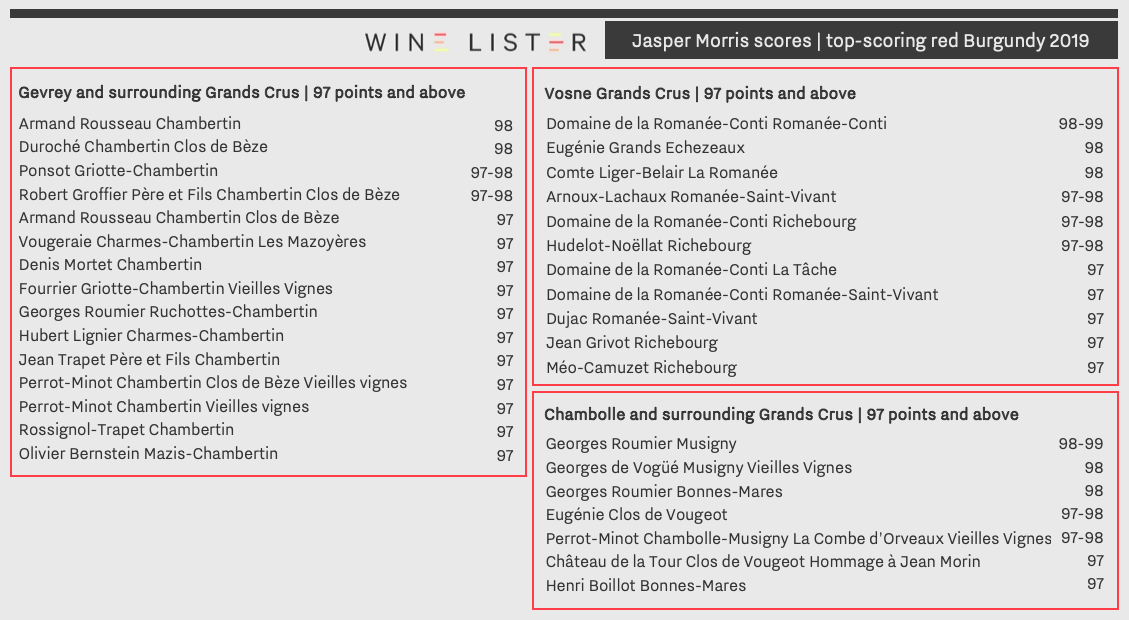
In Gevrey and its surrounding Grands Crus areas, Armand Rousseau fares well, its Chambertin and Chambertin Clos de Bèze earning scores of 98 and 97 respectively. Up-and-comer Domaine Duroché ties for first place within the subset with its Chambertin Clos de Bèze. Jasper describes it as having “a little lick of oak, which is entirely in place, a light, but fresh acidity, a sense of harmony throughout and a deepening of the fruit on the second half of the palate”, creating a “glorious conclusion”.
Georges Roumier proves king of Chambolle and its surrounding Grands Crus, earning two places among the top scorers for the domaine’s Musigny and Bonnes-Mares. Adding testament to the improving quality of maisons de négoce (as mentioned in Wine Lister’s Burgundy study), Maison Henri Boillot makes an appearance among the top ranks for its own Bonnes-Mares.
Domaine de la Romanée-Conti understandably dominates the Vosne Grands Crus category, though star producer Arnoux-Lachaux features among the top 11, in addition to its high-scoring Vosne-Romanée Premiers Crus. Speaking to Wine Lister following the completion of his Burgundy 2019 reports, Jasper notes that Arnoux-Lachaux has “unequivocally joined the greats with a faultless array of stunning wines in 2019, hitting heights of ethereal elegance without sacrificing power”.
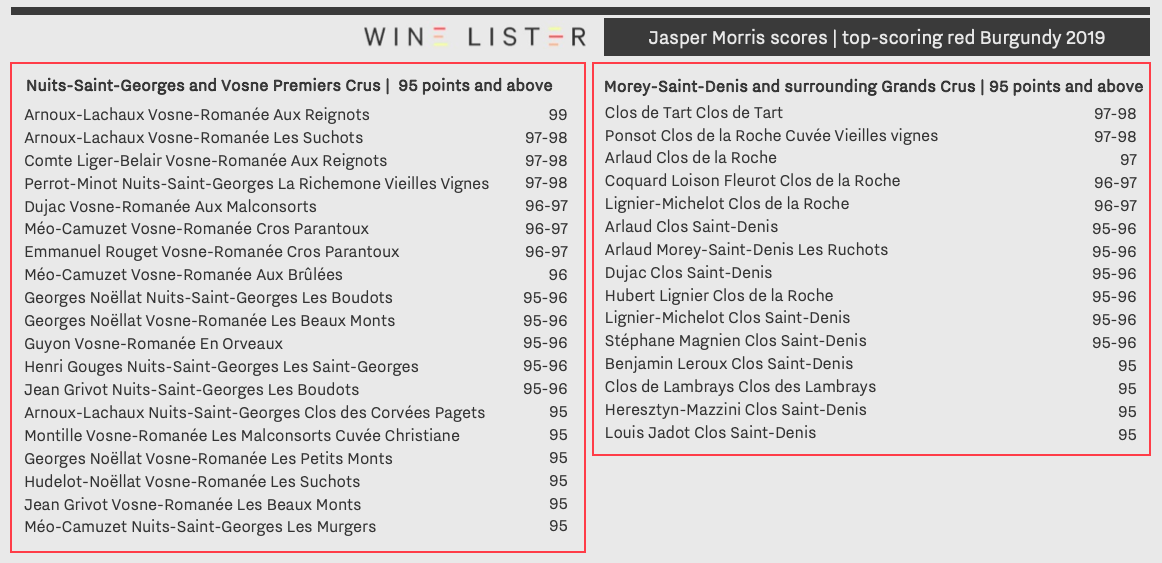
Jasper reports that Morey-Saint-Denis has done well in 2019, as “the village which had the benefit of the best rainfall figures in August”. He adds, “not only are Clos des Lambrays and Clos de Tart progressing well under their new ownerships and winemakers, but class acts such as Domaine Dujac and Christophe Perrot-Minot have filled their boots, while Domaine Arlaud have produced their best set of wines ever”.
Interestingly, no Côte de Beaune red scores above 96 from Jasper in 2019 (though the top scorer at 95-96 points is Méo-Camuzet’s Corton Rognet). See all top scores for Côte de Beaune reds in 2019 here.
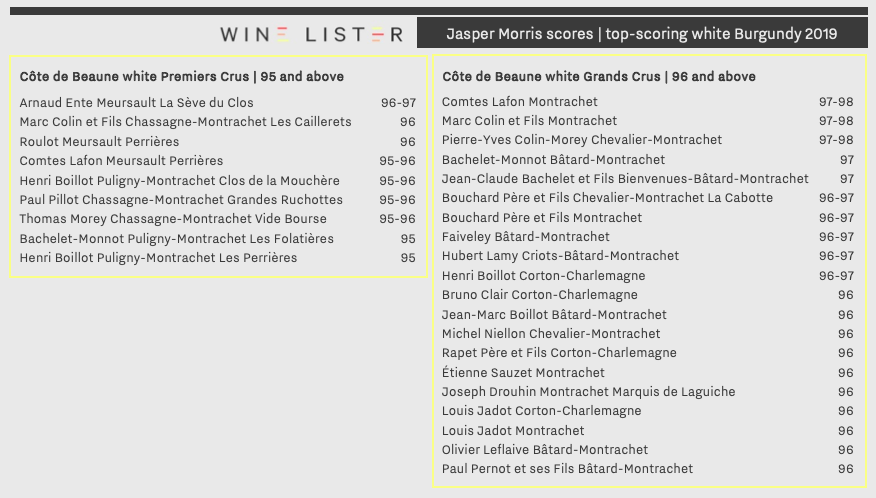
Whites in 2019 do not reach the dizzy score heights of their red counterparts. The above chart therefore takes into account Côte de Beaune white Premiers Crus with scores above 95, and Côte de Beaune Grands Crus achieving 96 points or above.
In the latter subset, maisons de négoce Bouchard Père et Fils and Maison Jadot achieve two entries apiece, for their Chevalier-Montrachet La Cabotte and Montrachet, and Corton-Charlemagne and Montrachet respectively.
Producers Bachelet-Monnot, Comtes Lafon, Domaine Henri Boillot, and Marc Colin also all appear twice in the top Côte de Beaune white rankings for 2019.
View more Burgundy 2019 scores here. Wine Lister Pro users can search and filter by critic scores, and can view all of Jasper Morris’ top Burgundy 2019 scores here. Click here to find out more about the Pro subscription.
The end of 2020 is perhaps reason enough to pop open a bottle of champagne. With Christmas and New Year around the corner, Wine Lister has compiled a list of 21 Champagne MUST BUYs to enjoy over the last days of this year, and into 2021. Whether you have a penchant for discovering grower champagnes, or prefer to relish in those the top Grandes Maisons have to offer; whether you enjoy the purity of a Blanc de Blancs, the balance of an assemblage, or the opulence of a Blanc de Noirs, the selection of vintage champagnes below is sure to offer guidance for any preferred style.
Find out more about our 21 Champagne MUST BUYs for 2021 below.
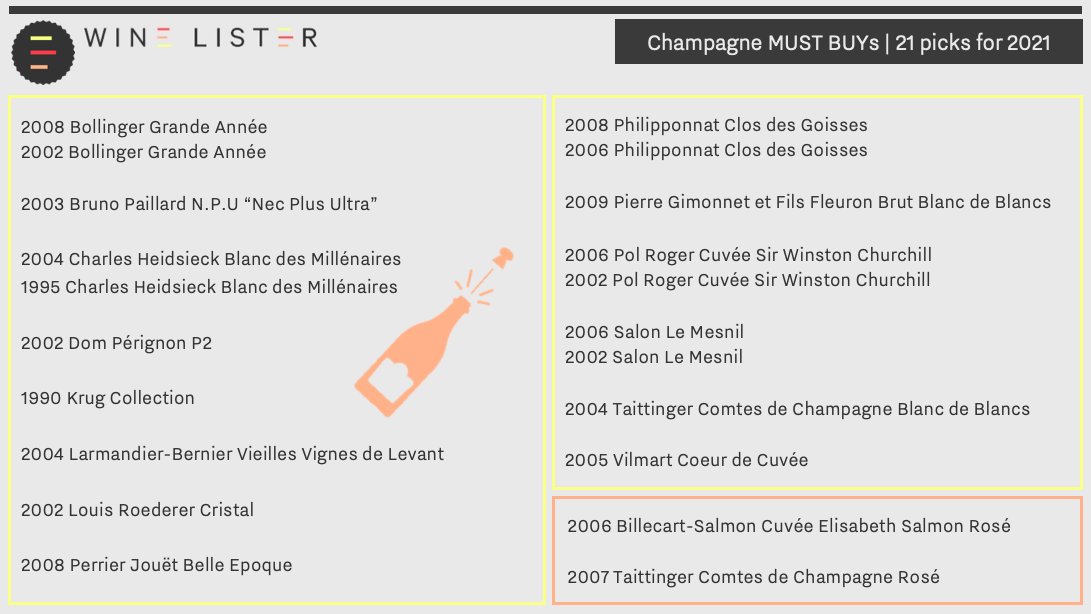
Long-established house, Charles Heidsieck, is represented in our MUST BUY selection with two vintages of its Blanc des Millénaires – 1995 and 2004. The wine is so-named to reflect its high ageing potential, and is only created in vintages worthy of the label (since its inception, just five have been made). The 2004 achieves a WL score of 95, and is praised by Wine Lister partner critic, Jancis Robinson, as having “sheer confidence, appeal and completeness”. Earning one more WL point, the 1995 shows “just how compelling this often-overlooked vintage can be”, according to Wine Lister partner critic, Antonio Galloni (Vinous). Both vintages can be bought by the case of six in-bond from Cru World Wine.
Also the crown jewel of its own house, Perrier-Jouët’s Belle Epoque carries its own portion of history within its name, referencing the Art Nouveau movement of the early 1900s. The prestige bottling can be appreciated on the inside and out, particularly in the spectacular 2008 vintage. Wine Lister tasted it recently, and found it to have a concentrated nose of white peaches, brioche, and a hint of honeysuckle, with brilliant tension on the palate. 2008 Belle Epoque is available to purchase by the bottle from Lay & Wheeler, for £129 (in-bond).
A further two MUST BUYs hail from the boutique house, Philipponnat Clos des Goisses. The 5.5-hectare Clos de Goisses parcel is the oldest and steepest “Clos” in champagne. The 2006 and 2008 vintages of this single-vineyard cuvée both receive a WL score of 96. Jancis Robinson praises both vintages, writing that the 2006 “positively screams for attention”, while the 2008 is “explosive… like a firework on the palate”. They can both be acquired in-bond from Bordeaux Index.
Included in our 21 MUST BUY champagnes are two grower offerings lying outside of champagne’s more widely-declared vintages. Notorious for its killer heatwave, 2003 is not well-appreciated among the champenois. Bruno Paillard’s 2003 N.P.U. challenges this perception, offering a “dancing” palette of “open and floral notes” according to Jancis Robinson. Acknowledging that the vintage was hugely criticised, Paillard says that for him, “it’s a great vintage”. Another elusive grower champagne rounds off our list. Jancis Robinson hailed the 2005 Vilmart Coeur de Cuvée as “a wine to wallow in”, praising its complexity and “refreshing finish”.
Also featured in the list of 21 Champagne MUST BUYs for 2021 are: 2006 Billecart-Salmon Cuvée Elisabeth Salmon Rosé, 2008 Bollinger Grande Année, 2002 Bollinger Grande Année, 2002 Dom Pérignon P2, 1990 Krug Collection, 2004 Larmandier-Bernier Vieilles Vignes de Levant, 2000 Louis Roederer Cristal, 2009 Pierre Gimonnet et Fils Fleuron Brut Blanc de Blancs, 2006 Pol Roger Cuvée Sir Winston Churchill, 2002 Pol Roger Cuvée Sir Winston Churchill, 2006 Salon Le Mesnil, 2002 Salon Le Mesnil, 2004 Taittinger Comtes de Champagne Blanc de Blancs, and 2007 Taittinger Comtes de Champagne Rosé
As 2020 draws to a close, Wine Lister has compiled a report celebrating the top-performing wines and producers within a series of categories over the past year. Using our axes of Quality, Brand, and Economics, and the several factors that constitute these values, we have created seven leagues that paint a panoramic view of some of the world’s best wines, ranked within their areas of excellence.
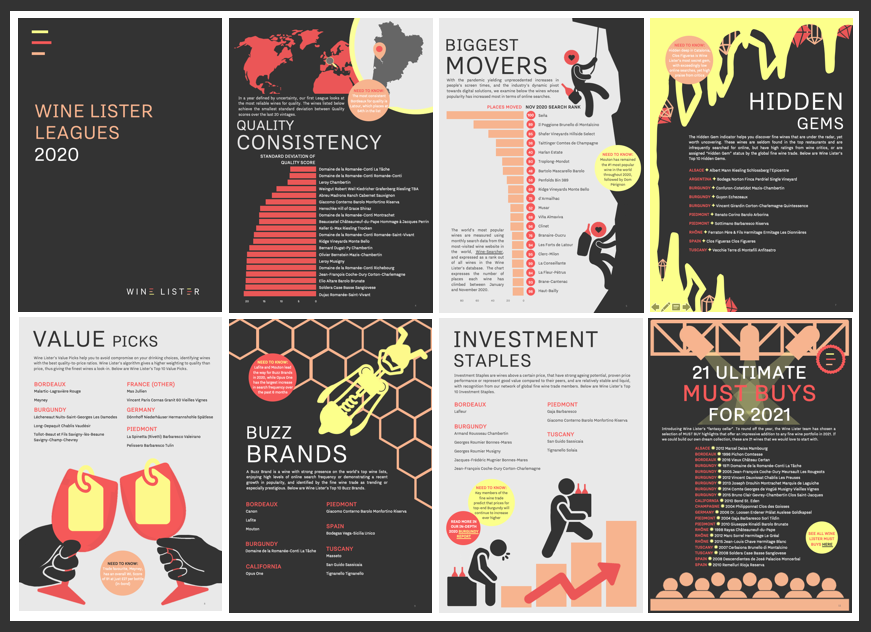
Wine Lister’s 2020 Leagues include rankings of Quality Consistency (wines that show the smallest standard deviation between Quality scores over the last 20 vintages), and Biggest Movers (wines whose popularity has increased most in terms of online searches over the past year). Our team has also put together its top-10 wines per Wine Lister Indicator, revealing our recommendations for Hidden Gems, Value Picks, Buzz Brands, and Investment Staples.
We end the Leagues with a list of 21 Ultimate MUST BUYs for 2021, compiling a selection of MUST BUY highlights hand-picked by our fine wine experts, that offer an impressive addition to any fine wine portfolio in 2021. These are some of the picks that would feature in Wine Lister’s “fantasy cellar”.
Download your free copy of Wine Lister’s 2020 Leagues here.
Top chefs are often interrogated on their favourite dishes to cook at home, actors on their favourite films, writers on their favourite books – Wine Lister has sought out the ultimate drinking inspiration for special occasions, interviewing a handful of top wine producers on their favourite wines.
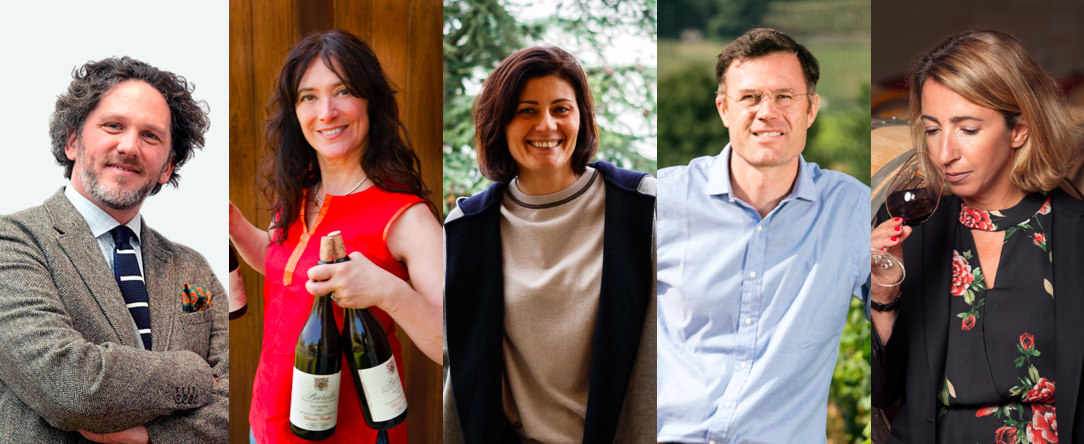 From left to right: Axel Heinz, Chiara Boschis, Gaia Gaja, Jacques Devauges, and Marielle Cazaux
From left to right: Axel Heinz, Chiara Boschis, Gaia Gaja, Jacques Devauges, and Marielle Cazaux
Axel Heinz – Ornellaia
“It’s certainly the most difficult question to answer for a winemaker”, Axel begins. Born in Germany, and spending his early career in Bordeaux before joining Ornellaia, his choice, once we twisted his arm, sits far from his professional vinous journey. “It would be a white, from my favourite Grand Cru in Burgundy: Corton Charlemagne”, he confesses, explaining that for him, these wines combine the structure and power of a red wine, with “the vibrancy, fragrance, and minerality that one can only find in great whites”. Admiring its capacity for a faithful expression of terroir, and display of true personal signature, he cites Coche-Dury as his go-to producer.
Chiara Boschis – E.Pira e Figli
With Barolo in her blood (her relatives founded the historic Giacomo Borgogno estate), it is not unusual that Chiara Boschis’ favourite wine should hail from this same noble Italian region. She tells us that she understood from a young age “the privilege to be born in such a generous land”, for which her parents, and the people around her had “great love and respect”. After years in the cellar at E.Pira, she too became “entirely captured by the magic of Barolo”. Chiara’s top choice is therefore a Barolo from the Mosconi vineyard for its “complexity and depth”, Cannubi for its “elegance”, and the vineyards of Via Nuova for their “diversity”.
Gaia Gaja – Gaja
While paying homage to her family’s past through her own wines, fifth generation winemaker, Gaia Gaja also has one eye on the future. Her favourite wine, from rising star appellation Mount Etna, Sicily, is Graci’s Etna Rosso Arcuria. The wine is made from one of the latest ripening European varieties, Nerello Mascalese, in one of the highest vineyards in Europe. She discovered it after “becoming close friends with Alberto Graci and his family”, often visiting them in Etna. Gaia explains that “the contrasts between its vibrancy, freshness, and warmth, as well as its perfume and smoky minerality”, remind her of “the snow and the fire of Etna”. Comparing it to Nebbiolo, she believes the grape has “intriguing personality, a strong identity of place, and a medium body that makes it versatile and easy to drink”.
Jacques Devauges – Clos des Lambrays
Moving from Clos de Tart to Clos des Lambrays last year, Jacques Devauges’ top wine of all-time was born close to home. He tells us that Comte Georges de Vogüé’s Musigny catalysed his passion for wine. Sampling the 1971 and 1978 as a teenager, he was “struck” by both, despite knowing very little about wine at that point. Jacques believes Vogüé’s Musigny shows “the signature of the Grand Vin”, to impress “not only the wine geek, or the collector, but everyone, even those who don’t know what makes a good wine”. Describing what “was almost a shock”, he notes that the “level of perfume on the nose was almost like a perfume you can put on your skin”, while the palate was “soft and delicate”.
Marielle Cazaux – La Conseillante
Joining La Conseillante from neighbouring Petit-Village in 2015, Marielle Cazaux tells us that if she had to pick a favourite wine, it would be Ridge Vineyards Monte Bello, because she “has so many special memories with this wine”. As an intern at Ridge in 2001, she had the chance to taste several vintages with the legendary Paul Draper, whom she calls “one of the most gifted winemakers of the US”. Marielle considers Monte Bello a “wine with extraordinary finesse”, and “a total sense of harmony”. Describing its notes of “black pepper, lavender, mocha, liquorice, and dried flowers”, she observes that it is “perhaps one of the most “Bordeaux” style wines in California”.
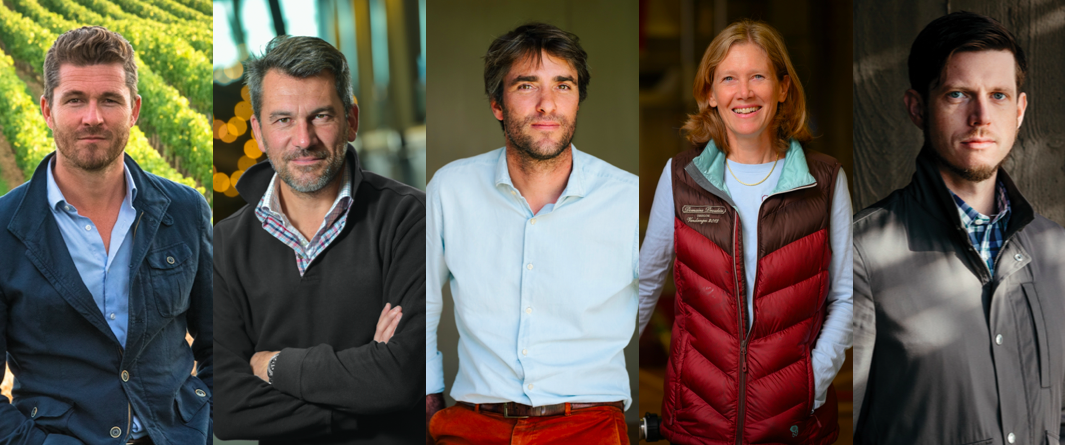 From left, Nicolas Audebert, Nicolas Glumineau, Pierre-Olivier Clouet, Veronique Boss Drouhin, and Will Harlan
From left, Nicolas Audebert, Nicolas Glumineau, Pierre-Olivier Clouet, Veronique Boss Drouhin, and Will Harlan
Nicolas Audebert – Rauzan-Ségla, Canon, and Berliquet
With some of the world’s most prestigious wineries under his belt (Terrazas de Los Andes, Cheval des Andes, Moët & Chandon, Krug, Veuve Clicquot), Nicolas echoes Axel Heinz in attempting to pick his favourite wine: “it’s impossible to answer. It’s like music – endless, initiatory, and progressive”. He instead recommends a wine from his friend, winemaker Andrea Felluga, with whom he “shares wine at simple, festive tables with lots of laughter”. He tells Wine Lister that Felluga’s wine, Livio Felluga Terre Alte “is a great white from Friuli” – a “land of contrast between the sunny and singing soul of Italy and the Alpine foothills, austere and cool”. Made from a blend of Friulano, Sauvignon Blanc, and Pinot Blanc, the Terre Alte is, according to Nicolas, like Felluga – “happy and lively”.
Nicolas Glumineau – Pichon Comtesse
On the subject of his favourite wine, Nicolas Glumineau (previously of Haut-Brion, Margaux, and Montrose), tells us that there are so many wines he could note – “Rayas 1990, E. Guigal La Mouline 1976, Cristal 1996, Trotanoy 2009, Diamond Creek Red Rock Terrace 2015”. White Burgundy legend, Coche-Dury, nonetheless gets another vote from Nicolas (on top of praise from Axel Heinz) as he reminisces trying the Meursault Caillerets 2006 for the first time in London, and being “choked, speechless, and moved by such perfection”. He describes the “delicacy of its white flower aromas and the elegance of its mineral and endless finish”, and recalls the feeling “that the world has stopped turning and that time has been suspended”.
Pierre-Olivier Clouet – Cheval Blanc
Echoing the sentiment of several of his peers, Pierre-Olivier Clouet (who has been at Cheval Blanc for 16 years), tells us that “it is impossible to choose just one wine”, because “like wine, the palate of the taster is constantly evolving”. Pierre-Olivier nonetheless notes his current favourite is “Mas Jullien – a wine that fully expresses the identity of the place where it is made, and injects the touch of balance and freshness that characterises all the great wines of the world”. He recalls that the last time he tasted the Languedoc red – a blend of Syrah, Carignan, and Mourvèdre – was with his team, on the last day of Cheval Blanc’s 2020 harvest.
Veronique Boss Drouhin – Joseph Drouhin
Fourth-generation winemaker, Veronique Boss Drouhin tells us that a wine she particularly enjoys was introduced to her by her close friend, Christine Vernay, daughter of the late Georges Vernay (praised for his key role in the survival of the Condrieu appellation). Veronique recalls Vernay opening a bottle of Georges Vernay Condrieu Coteau de Vernon, and being enchanted by its “aromatics, jumping out of the glass – unique, fragrant, and complex”, and a palate that was “powerful, voluptuous, and round, but with acidity to balance it” – a rarity for Viognier. She also cites Georges & Christophe Roumier’s Chambolle-Musigny Les Amoureuses as one of her favourites, adding, “Christophe’s [wine] is one of the nicest, purest, more elegant expressions of Pinot”.
Will Harlan – Promontory
Leading Harlan Estates‘ second-generation venture, Will Harlan explains to us that while he cannot choose a favourite, Jacques-Frederic Mugnier’s Musigny 2001 is a wine that he believes to “belong among the finest”. Will recalls coming across the bottle while “travelling with colleagues through Copenhagen a few years ago”, and as there hadn’t been a correct time to open it, the bottle joined them “on a course through Germany to Switzerland”. Having finally found an appropriate evening in Zurich to open it, “by the lake — the first bit of rest since the trip began”, he was “drawn in, as each feature of the wine, with a humble nobility, felt very naturally and confidently in its place”. Will notes it was a “wine that was singular and true”, that “would mark a memorable evening of our travels and in our friendships”.
The first of the Burgundy 2019 en primeur releases began this month, reigniting conversation of last year’s growing season, and its subsequent offerings. Wine Lister has spoken to several key Burgundy producers, and has sampled the 2019s from leading négociant, Louis Jadot, to get a better picture of this promising vintage.
Burgundy’s 2019 growing season was marked by a notably hot and dry summer, resulting in wines of extreme concentration. Due to a combination of spring frost, uneven flowering, and summer drought across many sites, yields in 2019 are significantly lower than average.
 A line-up from Louis Jadot’s 2019 en primeur tasting, organised by Hatch Mansfield at Vagabond, Monument on the 3rd of November 2020
A line-up from Louis Jadot’s 2019 en primeur tasting, organised by Hatch Mansfield at Vagabond, Monument on the 3rd of November 2020
Sourcing grapes from across the region, including its own holdings in some of Burgundy’s most prized plots (e.g. Chapelle Chambertin, Clos Vougeot, and Vosne-Romanée), Louis Jadot’s production in 2019 is down 50% for Chardonnay, and 30% for Pinot Noir. A cool and windy spring caused millerandage across Jadot’s sites, leading to many of the smaller, unripe berries being discarded. Warm temperatures in 2019 meant that grapes had high natural sugar levels, and correspondingly high alcohol across the region. Deputy General Manager, Thibault Gagey, tells us that several Louis Jadot wines are approaching 14 degrees in 2019, however, they nonetheless offer “good acidity, so they are powerful but balanced”, and there “isn’t a feeling of high alcohol”.
Wine Lister agrees whole-heartedly, and was particularly impressed by the quality of the whites. The Chablis Blanchot was “pure and lithe with an already-sumptuous texture”, while the Chassagne Montrachet Morgeot Clos de la Chapelle offered a delightful nose of “honey, truffle, and brioche”, with “rich citrus” on the palate. For reds, Wine Lister enjoyed the “complex and earth-toned” Clos Saint-Denis, and the “powerful but poised” Gevrey-Chambertin Clos Saint-Jacques. Gagey informs us that he is indeed “very proud of the 2019s”, and is “confident that it will be a good vintage”.
Across the Côte de Beaune, harvests were small in 2019. Arnaud Ente tells us that his namesake domaine saw “a spell of spring frost”, which caused significant damage and loss of yield, and “uneven weather patterns during flowering”, caused coulure and millerandage. The summer was mostly hot and dry, causing hydraulic stress to the vines, but “20-30mm of rainfall in late August” helped to unblock phenolic maturation, and allow the grapes to reach “impressive levels of maturity while maintaining good sugar levels, and also a very lovely acidity”. Ente notes that his 2019s have achieved “extraordinary balance, due to the acidity in the grapes developing slowly”. The vintage is of “enormous potential”, if down 20% on an average year in terms of volume.
Domaine Jean-Noël Gagnard similarly experienced significant frost in 2019; the principal cause of its small harvest. Winemaker Caroline Lestimé echoes the experience of “millerandage followed by hydraulic stress on the vines during the summer drought”, resulting in “small, but thankfully exceedingly concentrated berries”. Due to the two extremes of conditions throughout the season, Lestimé analysed the sugar / acid balance frequently near to harvest, so as to pick the optimum window for picking. Once again, quality here is likely a triumph, but Lestimé adds that “Jean-Noël Gagnard has not seen such a small harvest since 1999”.
Guillaume d’Angerville tells us that in Volnay, “frost risk was on everyone’s mind”, however, “dry and windy conditions helped to avoid frost damage” across Marquis d’Angerville’s plots. Water and heat stress in summer was a problem here too, “stopping the plant’s evolution, and veraison was delayed as a result”. He similarly explains that “selecting the correct harvest date proved difficult”, in part due to the “heterogenous grape maturation”, however in the end, “the entire range benefitted from the perfect maturity of the grapes”, despite yields being down 20-30% on the average year. He tells us that his 2019s are “succulent and full of energy”, without being “jammy” from such a hot year, and therefore providing “another successful vintage ending in 9”.
Akin to Louis Jadot, Winemaker Jean-Nicolas Méo tells us that Méo-Camuzet’s 2019s are “well-ripened”, with “fairly high alcohol levels, around 14 degrees”. He states that there is nonetheless “a nice acidity to start”, which provides the wines “a good freshness and a certain structure”, as well as lengthy ageing capacity. Echoing d’Angerville’s sentiment on the success of 9s, Méo foresees “an evolution of this vintage like the 2009: rich and greedy at first, then gradually closing, to emerge in a decade more tense and structured than suggested today”.
Despite the significantly reduced volumes in 2019, the quality of Burgundy’s latest vintage release clearly suggests a long and promising future ahead. The combination of these two factors will surely see demand outweigh supply for en primeur once again. For more guidance on buying Burgundy 2019 en primeur, and essential analysis to inform your wider Burgundy investment decisions, purchase our in-depth Burgundy study here.
Wine Lister’s recent in-depth Burgundy study considers the much-contended topic of the region’s rising prices, providing additional information for those planning on purchasing Burgundy 2019 en primeur over the coming months.
Below we examine the current distribution of prices of the 175 wines featured in the study, compared to the same wines two years ago. While 5% of wines were priced above £3,000 two years ago, a substantial 11% are today.
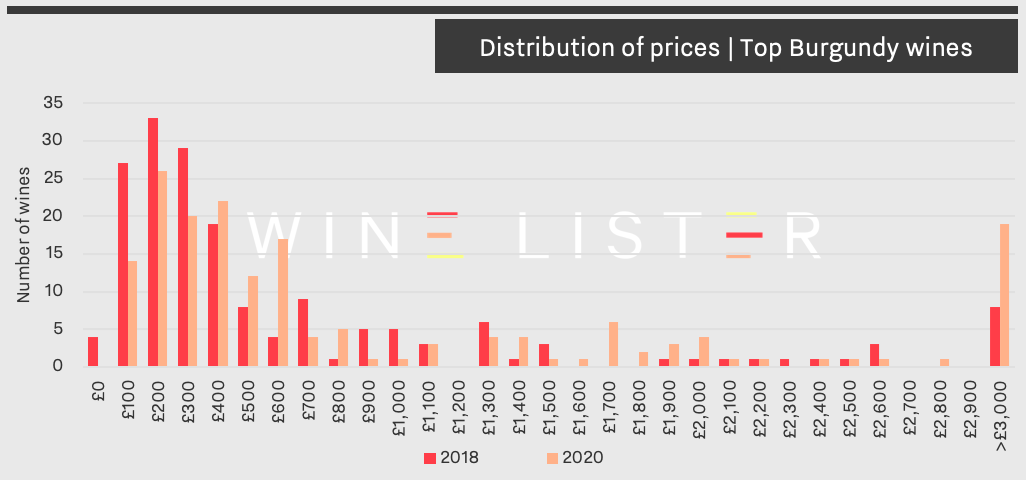
The graph above reveals a significant shift towards the higher end of the price scale, with multiple Burgundy wines previously priced between £1,900 and £2,700 now over £3,000. This comprises Comte Liger-Belair La Romanée, d’Auvenay’s Mazis-Chambertin and Bonnes-Mares, Domaine de la Romanée-Conti La Tâche, Jean-François Coche-Dury Corton-Charlemagne, and Leroy’s Richebourg, Romanée-Saint-Vivant, Clos de la Roche, Corton-Charlemagne, and Latricières-Chambertin.
Alongside the figures, feeling from Wine Lister’s recent Founding Member survey confirmed that Burgundy’s seemingly boundless prices are a concern, with over half of respondents voicing apprehensions on the topic. The most common sentiment is nonetheless that little will change for wines at the very top end, and that their prices will continue to climb, as demand continues to outweigh supply significantly. One specialist merchant in the Asian market informed us that they indeed foresee “Burgundy prices heading higher at the top end”, and that they “don’t see demand slowing despite the economic issues.”
The polarised prices illustrated in the graph are echoed by the trade, who cite a phenomenon of divergence between the top-end wines, and those at mid-range or entry-level. One respondent noted “an oversupply of generic and village Burgundy”, with another predicting that “when the smoke clears, all that remains will be Bourgogne Rouge/Blanc and the crown jewels, with no market in between”.
Despite the geopolitical context of the past two years, the buzz surrounding Burgundy remains strong, and competition will be hot for accessing the best wines of the 2019 vintage, particularly given its reduced production volume.
Visit the Analysis page to purchase Wine Lister’s in-depth 2020 Burgundy study, or download it using your Pro subscription here (available in both English and French).
Before the bulk of Burgundy en primeur 2019s are released onto the market, Wine Lister has published its second in-depth Burgundy study.
Below we explore the complex relationship between the region’s price performance and its popularity growth over the past two years, informing your investment decisions over the coming months.
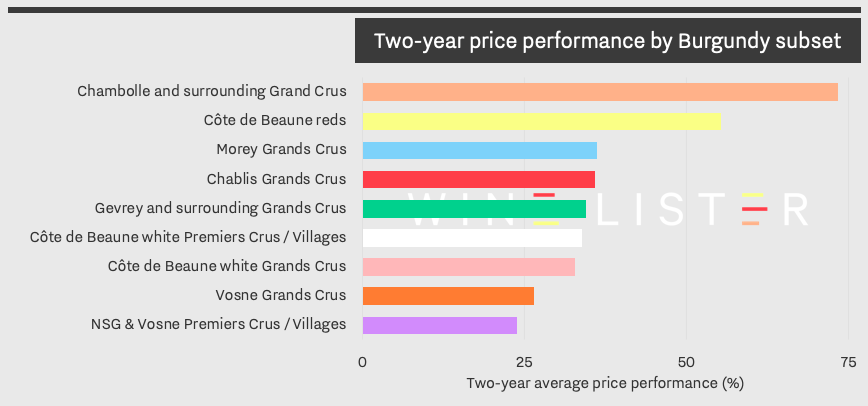 The two-year price performance of a basket of 175 Burgundy wines (the same wines featured in our previous study on the region in 2018), based on the last 30 vintages. Price data partner: Wine Owners.
The two-year price performance of a basket of 175 Burgundy wines (the same wines featured in our previous study on the region in 2018), based on the last 30 vintages. Price data partner: Wine Owners.
As shown in the chart above, Chambolle and its surrounding sites lead in the price performance of Burgundy Grand Crus, followed by wines hailing from its northerly neighbour, Morey-Saint-Denis. The notorious sub-set of Grand Crus from around Vosne – home of legendary Richebourg, La Tâche, Echezeaux, and Romanée-Conti – has seen slower price performance, which is matched with lower popularity growth (see below).
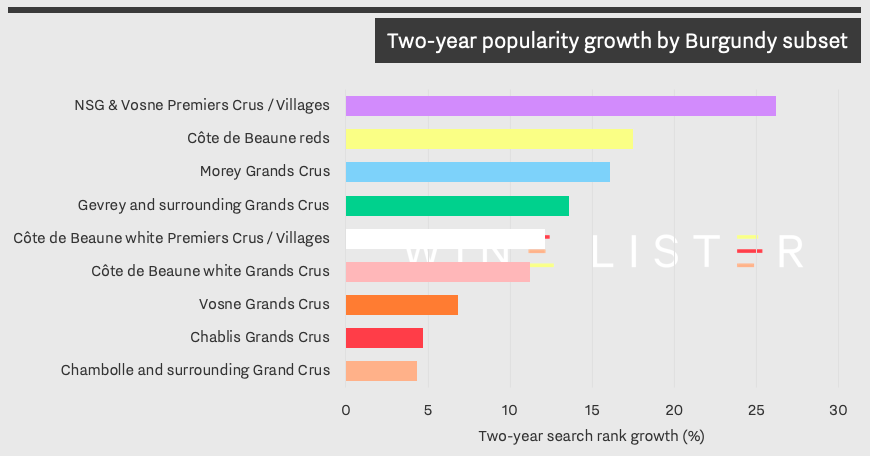 The two-year popularity growth of each Burgundy subset. Popularity data partner: Wine-Searcher.
The two-year popularity growth of each Burgundy subset. Popularity data partner: Wine-Searcher.
Though Chambolle and its surrounding Grand Crus have excelled in two-year price growth, consumer interest in the wines of this subset increased the least. Following similarly this opposing relationship between the two data sets, Nuits-Saint-Georges / Vosne Premiers Crus and Village wines gained the most popularity over the last two years by a large margin, while the subset’s price performance trails behind in last place.
A growing interest in lower-priced wines from Burgundy is further explored through trends identified by key members of the international fine wine trade in Wine Lister’s report. Producers such as Arnoux-Lachaux and Georges Mugneret-Gibourg are well worth looking out for when buying Burgundy en primeur for drinking in several years’ time.
Visit the Analysis page to purchase Wine Lister’s in-depth 2020 Burgundy study, or download it using your Pro subscription here (available in both English and French).
“Finché c’è vino c’è speranza” – As long as there is wine, there is hope.
Never before have Italian winegrowers been able to dedicate as much time to the care of their vineyards as in 2020. The Consorzio Vino Chianti Classico and several further Tuscan producers cite this silver lining to Covid restrictions, and they suspect it will reveal itself in the wine to come. In a year that has caused tribulation across the world, news of Italy’s promising 2020 harvest is certainly welcomed. Wine Lister has spoken to several Italian estates, which reportedly yielded high-quality grapes across the board. While regions – Piedmont and Tuscany – had their respective weather nuances, the general consensus suggests that growing season conditions were balanced, with no mention of hail or storms.
In Montalcino, the Mastrojanni team explained that lockdown prompted improved vineyard inspection in 2020: “[people] couldn’t work indoors in their offices, so the vines received the utmost attention”. They report a “very good harvest” this year, comparing it to the high-scoring 2013. Despite two short heatwaves in July and August, the estate had a mild summer overall, thanks to cooling winds that flow through the Amiata Valley in which its vineyards are situated.
On the other side of Montalcino, Cinelli Colombini reported frost during budburst, which limited the number of grape clusters in 2020. Several other Tuscan producers spoke of reduced volumes due to the cold start to spring (Fattoria Le Pupille’s 2020 yield is 20% lower than last year). Cinelli Colombini’s Brunello grape harvest was nonetheless of “excellent quality”, and despite it being hard to “shine after a masterpiece of a vintage like 2019”, the team believes it will be “difficult to exclude it from being among the best five vintages of the last 20 years”.
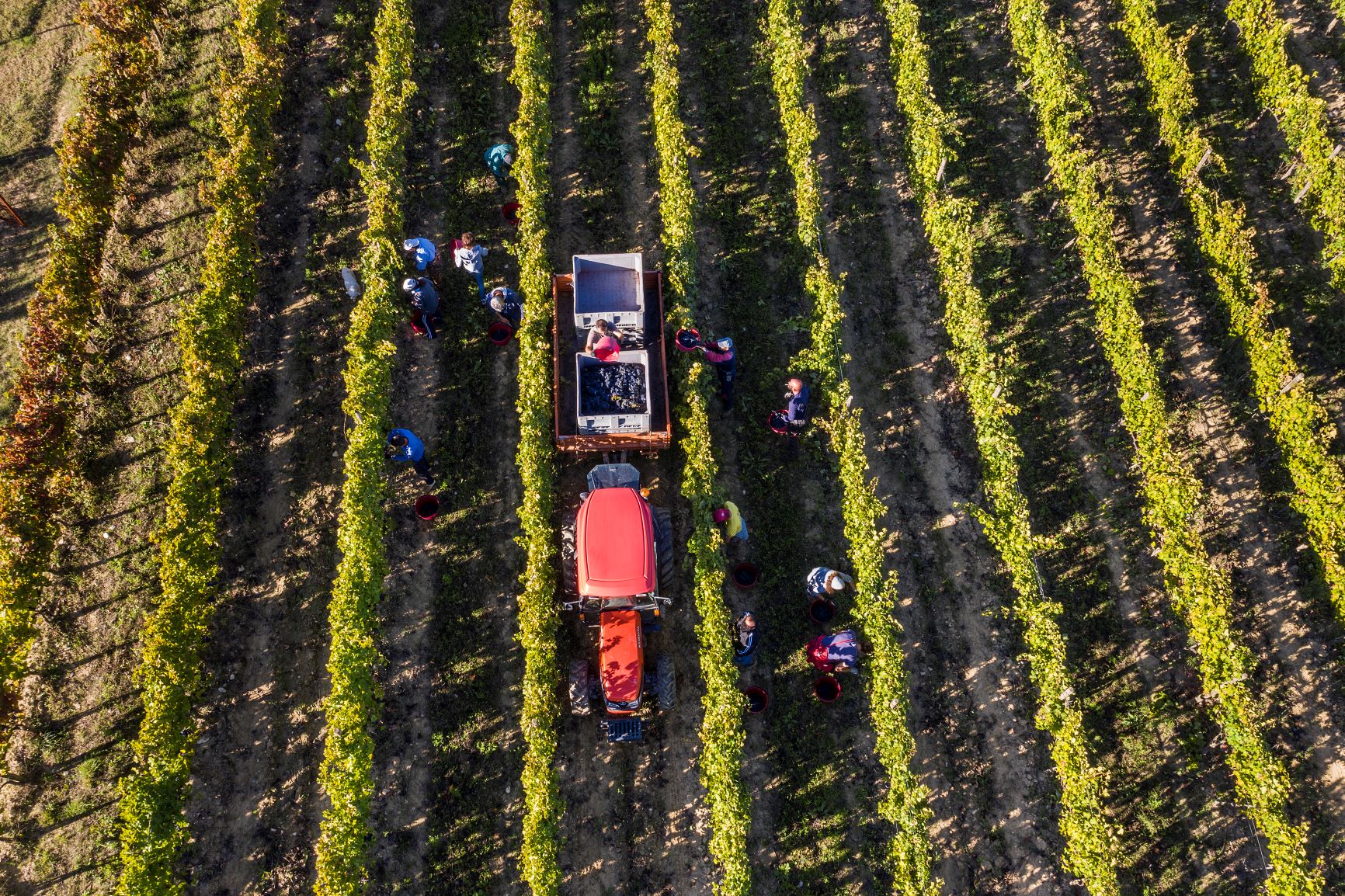 All hands on deck: the 2020 Brunello harvest at Montalcino’s Cinelli Colombini
All hands on deck: the 2020 Brunello harvest at Montalcino’s Cinelli Colombini
In Chianti, Castello di Monsanto began picking its Chardonnay grapes on 8th September, and collected its final Sangiovese on 10th October. Third-generation owner, Laura Bianchi, informed us that their spring was mild, with enough rain to create a “perfect” reserve of water for the vines. After the hot and dry August, a wet start to September helped to regulate maturation – a common theme throughout Tuscany in 2020. The grapes thus developed a “great balance of sugar, pH, and phenolic maturation”, and the first fermentation already suggests a vintage of “great personality, rich tannins, and beautiful acidity”. Further east, Vecchie Terre di Montefili started picking on 29th September – late in comparison to other producers, but normal, the team explains, for their vineyards, which lie 500 metres above sea level (and therefore require a longer maturation period).
Less than an hour away, Brancaia finished its harvest on 30th September (having started on the 3rd week of August). The team tells us that they were forced to harvest their Sangiovese quickly before heavy rain arrived, but that they were lucky that the grapes were “the perfect grade of ripeness”. In contrast, IPSUS owner, Giovanni Mazzei, explains that he and winemaker Gionata Pulignani decided to wait until after the extra rain in September before starting the harvest, “to guarantee more balance, extra aromatics, and temper the alcohol content”. In doing so, the hot and dry summer was counterbalanced; Mazzei states that he could indeed “classify the [2020] as a good compromise between cooler and hotter vintages”.
In coastal Maremma, owner and Production Manager at Fattoria Le Pupille, Ettore Rizzi, tells us that 2020 saw a significant threat of powdery mildew across its vines, especially in the thin-skinned varieties of Sangiovese, Ciliegiolo, and Syrah. He states that they nonetheless managed to trim the affected bunches and stem the problem, while their Merlot and Cabernet vines also “gave us some incredible fruit”. According to Rizzi, “the word that can best describe the 2020 vintage is concentration” – a consequence of the high temperatures in July and August.
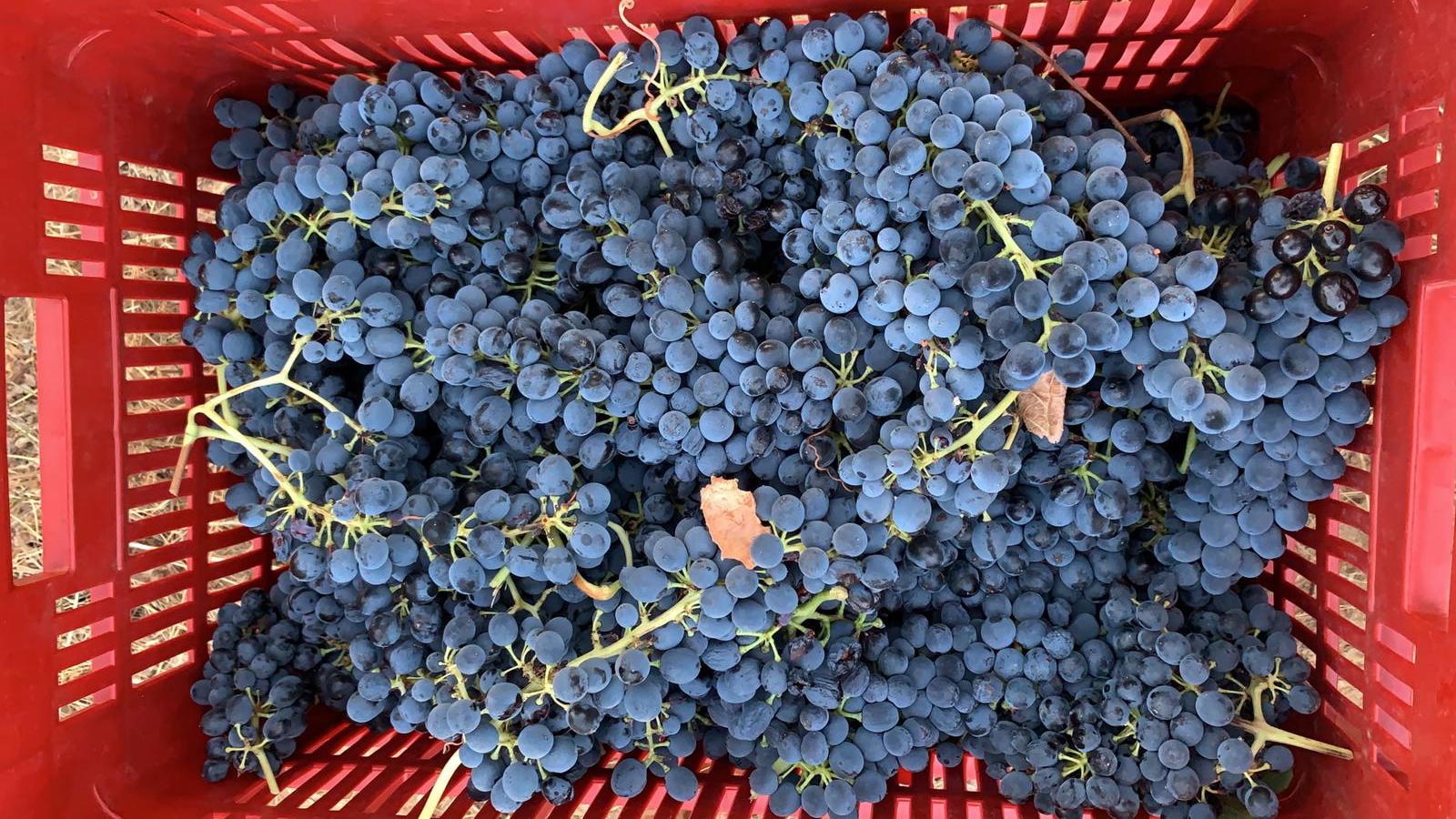 “The final quality of the grapes was really good” – Fattoria Le Pupille’s 2020 Syrah grapes
“The final quality of the grapes was really good” – Fattoria Le Pupille’s 2020 Syrah grapes
In Bolgheri, Ornellaia’s Estate Director, Axel Heinz, declared that their 2020 vintage is “shaping up to be one to remember as a great year”. The property saw “textbook perfect conditions until the end of May”, while June saw a lot of rainfall that “accelerated vine growth”, and required lots of work in the vineyard to keep the canopies under control. Summer saw hot and dry conditions, while rain arrived in the last days of August to alleviate drought stress and lower temperatures, encouraging a more even ripening at the last moment. While an unexpected mid-September heatwave made it necessary to pick all three red varieties – Cabernet Franc, Cabernet Sauvignon, and Petit Verdot – simultaneously at speed, Heinz notes that they nonetheless look “very promising in a rich and structured style”.
Moving up to Piedmont, fifth-generation of the esteemed Gaja family, Giovanni Gaja, tells us that they are so far “optimistic” about the 2020 vintage, despite it being early days to evaluate the exact character of the grapes. Their Barbaresco plots witnessed a moderate July, followed by a warm August that was similarly alleviated by rain towards the end of the month. While they required extra efforts to prevent mildew attacks, the final picked grapes appear “very healthy”.
While 2020 has caused much uncertainty, the recent harvest suggests that there is definitely hope for some excellent wine to come from this year, and we look forward to finding out for ourselves in the future.















